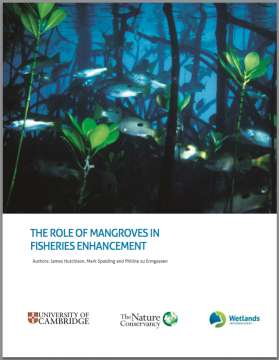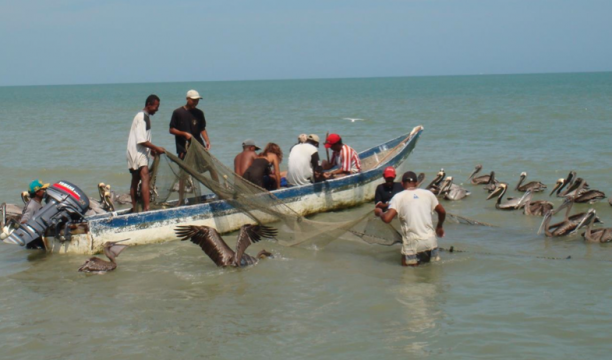The Role of Mangroves in Fisheries Enhancement


Some 210 million people live in low elevation areas within 10 km of mangroves and many of these directly benefit from mangrove-associated fisheries. Yet, these people are often unaware of the key role mangroves may play, especially if the associated fisheries are offshore.
A new study by Wetlands International, The Nature Conservancy and the University of Cambridge concludes that mangrove conservation and restoration in areas close to human populations will render the greatest return on investment with respect to enhancing fisheries.
The fisheries value of mangroves is site specific as it depends on how many fish a mangrove produces, how many fish are subsequently caught by humans, and then what the fisheries value is, both in economic terms, as a food supply or through the livelihoods that they support.
As demands for fish continues to rise with the increase of coastal populations and rapidly growing economies, understanding where mangrove-associated fish productivity is highest is critical. Well-known species that rely on mangroves in one way or another include crabs, prawns, mullet, herring, anchovy, snappers and groupers.
Fisheries value site specific
The values of fisheries, which can be stated in simple catch statistics, in monetary terms, as a food supply or through the livelihoods that they support, are site specific. The study concludes that fish populations that rely on mangroves will be highest where mangrove biomass productivity is highest, as leaves and woody materials form a key part of the marine food chains.Fish productivity is also higher where there is high freshwater input from rivers and rainfall and where mangroves are in good condition. The total area of mangrove is clearly important in determining the total numbers of fish, but the length of the mangrove margin is also key, since generally it is the fringes of mangroves where fish populations are enhanced.
Root structure of the mangrove belt
Physical characteristics of mangroves, such as the dense tangle of aboveground roots, also enhance fisheries. Oysters grow on the roots, and the roots trap sediment thus creating soft soils ideal for molluscs and crustaceans to burrow in. The roots further provide shelter against predation. By providing food and shelter mangroves are perfect and safe nursery grounds for many species.
Safeguarding mangroves in densely populated areas
Fish catch will be highest close to areas of high human population density that provide the fishers and the markets for the catch. While these mangroves are generally under greater threat as a result of degradation, pollution and over-fishing, appropriate mangrove and fisheries management give the greatest value.
Dr Mark Spalding, senior marine scientist at The Nature Conservancy said:“We conclude that mangrove conservation and restoration efforts in areas close to human populations will likely give the greatest return on investment for enhancing fisheries”.
Dr. Femke Tonneijck, Wetlands International: “Many decision-makers and fishers are unaware of the key role mangrove forests may play in supporting fisheries, including offshore. We hope that the fuller understanding of this ecosystem service and its value in both social and economic terms will enhance the sustainable management of both mangroves and fisheries.”

Mangrove dependent fishers in Latin America. Photo by Wetlands International.
Extract from Conclusions
The review work has helped to inform a detailed understanding of many of the fisheries and a generalised understanding of the processes which drive value. From this work we have developed a simple conceptual model of the key drivers of fisheries value, including the biophysical factors that determine how many fish a mangrove produces, and the socio economic factors that determine how many of these fish are caught by humans. This includes what the fish are worth in economic terms, both as a food supply and through the livelihoods that they support. From these models we can predict where mangroves are likely to be of particular value to fisheries:
- Fish productivity from mangroves will be highest where mangrove productivity is high, where there is high freshwater input from rivers and rainfall and where mangroves are in good condition.
- Fish productivity will increase with an increase in total area of mangroves, but notably also with the length of mangrove margin since generally it is the fringes of mangroves where fish populations are enhanced. This will also be influenced by geomorphology, with the network of channels, pools and lagoons all contributing to the margin length.
- Mangroves with greater structural complexity will enhance fisheries to a greater extent. The structure of roots varies between different mangrove tree groups, and isimportant for shelter that the roots provide to juvenile fish and prawns, and attachment points for bivalves.
- Fish catch will be highest close to areas of high human population density that provide the fishers and the markets for the catch. Some of these mangroves close to populations are also likely to be under greater threat than those in more sparsely populated areas – they may be degraded, the waters may be polluted, or they may be over-fished and hence less productive. Where such mangroves are secured through management regimes, and where their fisheries are well managed they are likely to give greatest value. Conversely, conservation and restoration efforts in these areas close to human populations will likely give the greatest return on investment.
Authors
James Hutchison, Mark Spalding and Philine zu Ermgassen
(0) Comments
There is no content